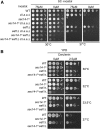NuA4 Lysine Acetyltransferase Complex Contributes to Phospholipid Homeostasis in Saccharomyces cerevisiae
- PMID: 28455416
- PMCID: PMC5473759
- DOI: 10.1534/g3.117.041053
NuA4 Lysine Acetyltransferase Complex Contributes to Phospholipid Homeostasis in Saccharomyces cerevisiae
Abstract
Actively proliferating cells constantly monitor and readjust their metabolic pathways to ensure the replenishment of phospholipids necessary for membrane biogenesis and intracellular trafficking. In Saccharomyces cerevisiae, multiple studies have suggested that the lysine acetyltransferase complex NuA4 plays a role in phospholipid homeostasis. For one, NuA4 mutants induce the expression of the inositol-3-phosphate synthase gene, INO1, which leads to excessive accumulation of inositol, a key metabolite used for phospholipid biosynthesis. Additionally, NuA4 mutants also display negative genetic interactions with sec14-1ts , a mutant of a lipid-binding gene responsible for phospholipid remodeling of the Golgi. Here, using a combination of genetics and transcriptional profiling, we explore the connections between NuA4, inositol, and Sec14 Surprisingly, we found that NuA4 mutants did not suppress but rather exacerbated the growth defects of sec14-1ts under inositol-depleted conditions. Transcriptome studies reveal that while loss of the NuA4 subunit EAF1 in sec14-1ts does derepress INO1 expression, it does not derepress all inositol/choline-responsive phospholipid genes, suggesting that the impact of Eaf1 on phospholipid homeostasis extends beyond inositol biosynthesis. In fact, we find that NuA4 mutants have impaired lipid droplet levels and through genetic and chemical approaches, we determine that the genetic interaction between sec14-1ts and NuA4 mutants potentially reflects a role for NuA4 in fatty acid biosynthesis. Altogether, our work identifies a new role for NuA4 in phospholipid homeostasis.
Keywords: FAS1/FAS2; cerulenin; inositol/choline responsive elements (ICREs); steryl esters; triacylglycerols.
Copyright © 2017 Dacquay et al.
Figures





Similar articles
-
Transcriptional regulation of phospholipid biosynthesis is linked to fatty acid metabolism by an acyl-CoA-binding-protein-dependent mechanism in Saccharomyces cerevisiae.Biochem J. 2007 Oct 15;407(2):219-30. doi: 10.1042/BJ20070315. Biochem J. 2007. PMID: 17593018 Free PMC article.
-
Role of the unfolded protein response pathway in regulation of INO1 and in the sec14 bypass mechanism in Saccharomyces cerevisiae.Genetics. 2002 Sep;162(1):29-43. doi: 10.1093/genetics/162.1.29. Genetics. 2002. PMID: 12242221 Free PMC article.
-
Genomic analysis of the Opi- phenotype.Genetics. 2006 Jun;173(2):621-34. doi: 10.1534/genetics.106.057489. Epub 2006 Apr 2. Genetics. 2006. PMID: 16582425 Free PMC article.
-
Regulation of phospholipid synthesis in the yeast Saccharomyces cerevisiae.Annu Rev Biochem. 2011;80:859-83. doi: 10.1146/annurev-biochem-060409-092229. Annu Rev Biochem. 2011. PMID: 21275641 Free PMC article. Review.
-
Phospholipid synthesis in yeast: regulation by phosphorylation.Biochem Cell Biol. 2004 Feb;82(1):62-70. doi: 10.1139/o03-064. Biochem Cell Biol. 2004. PMID: 15052328 Review.
Cited by
-
Fine-tuning acetyl-CoA carboxylase 1 activity through localization: functional genomics reveals a role for the lysine acetyltransferase NuA4 and sphingolipid metabolism in regulating Acc1 activity and localization.Genetics. 2022 Jul 30;221(4):iyac086. doi: 10.1093/genetics/iyac086. Genetics. 2022. PMID: 35608294 Free PMC article.
-
JAZF1: A metabolic actor subunit of the NuA4/TIP60 chromatin modifying complex.Front Cell Dev Biol. 2023 Apr 7;11:1134268. doi: 10.3389/fcell.2023.1134268. eCollection 2023. Front Cell Dev Biol. 2023. PMID: 37091973 Free PMC article. Review.
-
Octopus-toolkit: a workflow to automate mining of public epigenomic and transcriptomic next-generation sequencing data.Nucleic Acids Res. 2018 May 18;46(9):e53. doi: 10.1093/nar/gky083. Nucleic Acids Res. 2018. PMID: 29420797 Free PMC article.
-
Uncovering the Role of the Yeast Lysine Acetyltransferase NuA4 in the Regulation of Nuclear Shape and Lipid Metabolism.Mol Cell Biol. 2024;44(7):273-288. doi: 10.1080/10985549.2024.2366206. Epub 2024 Jul 4. Mol Cell Biol. 2024. PMID: 38961766 Free PMC article.
-
Phenomic screen identifies a role for the yeast lysine acetyltransferase NuA4 in the control of Bcy1 subcellular localization, glycogen biosynthesis, and mitochondrial morphology.PLoS Genet. 2020 Nov 30;16(11):e1009220. doi: 10.1371/journal.pgen.1009220. eCollection 2020 Nov. PLoS Genet. 2020. PMID: 33253187 Free PMC article.
References
-
- Alfaro G., Johansen J., Dighe S. A., Duamel G., Kozminski K. G., et al. , 2011. The sterol-binding protein Kes1/Osh4p is a regulator of polarized exocytosis. Traffic 12: 1521–1536. - PubMed
-
- Ambroziak J., Henry S. A., 1994. INO2 and INO4 gene products, positive regulators of phospholipid biosynthesis in Saccharomyces cerevisiae, form a complex that binds to the INO1 promoter. J. Biol. Chem. 269: 15344–15349. - PubMed
MeSH terms
Substances
Grants and funding
LinkOut - more resources
Full Text Sources
Other Literature Sources
Molecular Biology Databases
Research Materials
Miscellaneous
